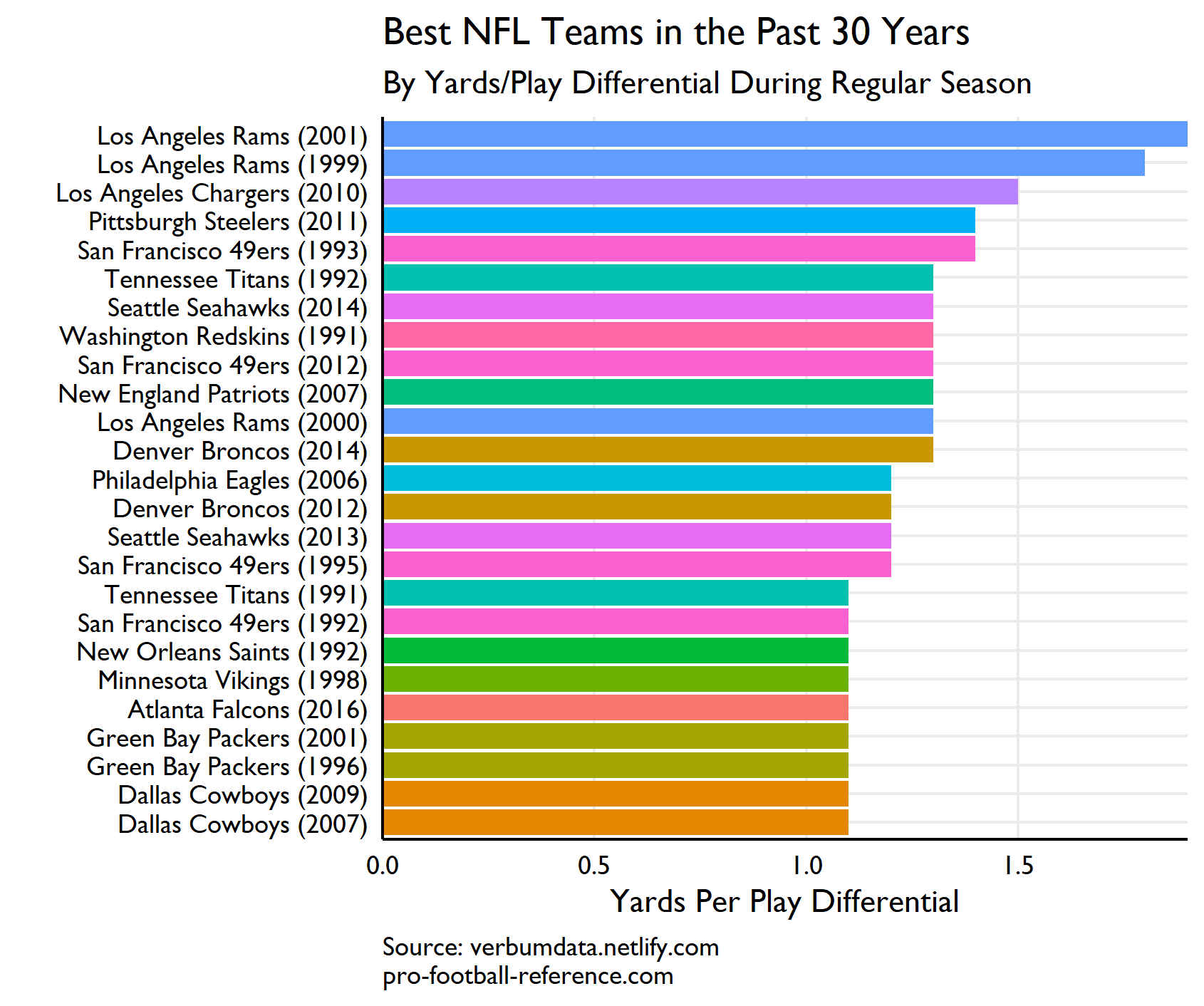This quick post was inspired by an Aaron Schatz tweet today which remarked on the quantitatively “best” team in the recent past:
He links to pro-football-reference.com. I took a gander and saw immediately that the website makes yards per play easily available.
As luck would have it, your author was lately preoccupied with just this statistic. 2018 NFL data I analyzed in the recent past show that a positive yards per play differential (at the game level) translates into a win about 70% of the time.
So why not look at the best teams of the last 30 years according to yards per play differential?!?
Here are the results (before the code):

How we got here…
First up are formalities of loading libraries and saving plot settings.
library(rvest)
library(tidyverse)
library(janitor)
library(extrafont)
# set theme
theme_set(
theme_minimal(base_family = "Gill Sans MT") +
theme(
axis.line = element_line(color = "black"),
axis.text = element_text(color = "black"),
panel.grid.minor = element_blank(),
plot.caption = element_text(hjust = 0)
)
)Now can proceed to the good stuff: web-scraping. To start the process, we will:
- Use
rvest::read_htmlto read in the relevant base website - Create our own links with each team’s abbreviation and the years from 1990-2019
- Celebrate
# get team abbreviations
team_abbs <- read_html("https://www.pro-football-reference.com/teams/")
links <- paste0(
"https://www.pro-football-reference.com",
team_abbs %>%
html_nodes("a") %>%
html_attr("href") %>%
.[grepl("teams\\/[a-z]{3}\\/$", .)] %>%
rep(2019-1990+1),
sort(rep(1990:2019, 32)),
".htm"
)Grab the data
We have the links. Now we need to write a function to take those links, scrape the data, and clean it up for us to evaluate.
# get best ypp differential w custom function
yppDiff <- possibly(
function(link) {
# read in html
pg <- read_html(link)
# extract stats of interest
stats <- pg %>%
html_nodes("table") %>%
html_table() %>%
.[[1]]
# fix names and clean up df
names(stats) <- unlist(ifelse(names(stats) == "", stats[1, ], paste(names(stats), stats[1, ], sep = "_")))
stats <- clean_names(stats)
names(stats)[names(stats) %in% c("tot_yds_to_ply", "tot_yds_to_y_p")] <- c("plays", "ypp")
stats <- stats[-1, ]
# add in team name & year
stats$team <- str_extract(link, "(?<=teams\\/).+?(?=\\/)")
stats$year <- str_extract(link, "\\d{4}")
stats <- stats %>% select(team, year, everything())
return(stats)
},
otherwise = NA_character_
)With the function written, we can pipe it into execution. Now, before anyone complains about my for loop, I will tell you that from the violence of historical web-scraping, the loop is advantageous over base::lapply or purrr::map in only one respect: if it fails, you easily keep your progress. Yes, purrr trickery can save you, but this is so much easier…I also like the facility with which I can add a “counter” to check progress (I deleted it so it wouldn’t show on the post).
# get data
hist_data <- list()
for(i in seq_along(links)){
hist_data[[i]] <- yppDiff(links[i])
}
# drop na & bind rows
hist_clean <- hist_data[!is.na(hist_data)] %>%
bind_rows() %>%
as_tibble()Now, you’ll no doubt already know, but your author is lazy. Thus, I needed a quick mapping from the teams’ url abbreviations to human names. Thus the following chunk.
# now get team mapping
team_links <- links[grepl("2019", links)]
team_name <- possibly(
function(link) {
team_pg <- read_html(link)
name <- team_pg %>%
html_nodes("h1") %>%
html_text() %>%
str_remove_all("\n|\\s{3,}|\\d{4,}|Statistics & Players")
df_out <- tibble(
abbr = str_extract(link, "(?<=teams\\/).+?(?=\\/)"),
name = name
)
},
otherwise = NA_character_
)
team_lookup <- map_dfr(team_links, team_name)YPP FTW
Now all the pieces can come together. We can positively determine the best teams of the past 30 years!
# find best ypp diff
ypp_rank <- hist_clean %>%
filter(player %in% c("Team Stats", "Opp. Stats"),
year != "2019") %>%
select(team, year, player, ypp) %>%
pivot_wider(
names_from = "player",
values_from = "ypp",
names_repair = "universal"
) %>%
mutate_at(vars(-team), list(as.numeric)) %>%
mutate(ypp_diff = Team.Stats - Opp..Stats) %>%
arrange(-ypp_diff) %>%
slice(1:25) %>%
left_join(team_lookup, by = c(team = "abbr")) %>%
mutate(ypp_unique = paste0(name, " (", year, ")"))And let’s plot.
ggplot(ypp_rank, aes(fct_reorder(ypp_unique, ypp_diff), ypp_diff)) +
geom_col(show.legend = FALSE, aes(fill = team)) +
coord_flip() +
scale_y_continuous(expand = c(0,0)) +
labs(x = "",
y = "Yards Per Play Differential",
title = "Best Teams in the Past 30 Years By Yards/Play Differential",
caption = "Source: verbumdata.netlify.com\npro-football-reference.com")
The 2001 Rams of Kurt " don’t forget Jesus " fame top our list. What a fabulous team. Aaron’s 1996 Green Bay Packers arrive at 22nd on the list. Not too shabby, but not the best. Oh, and, PS, I dropped all 2019 data for sake of small sample.